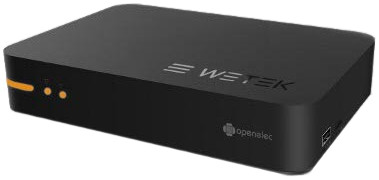 The XBMC Foundation’s Team Kodi last week released version 15 of its popular, open source Kodi media player and home theater framework. The “Isengard” release of Kodi (formerly XBMC) offers enhancements ranging from new chapter support to an improved add-on manager, but the biggest news is the completion of the Android version.
The XBMC Foundation’s Team Kodi last week released version 15 of its popular, open source Kodi media player and home theater framework. The “Isengard” release of Kodi (formerly XBMC) offers enhancements ranging from new chapter support to an improved add-on manager, but the biggest news is the completion of the Android version.
Kodi for Android, which has been available as a beta on Google Play since mid-June, is the last major OS platform to receive support, joining Windows, Linux, Mac, and iOS. Recently, the Kodi-focused OpenELEC Linux distribution joined with WeTek to release a special OpenELEC media player (see farther below).
The long-awaited Kodi for Android is all the more important since Amazon abruptly dropped Kodi from the Amazon Appstore in early June. Kodi has been a popular side-loading option for Amazon Fire tablets and media players, especially the low-cost Fire TV Stick.
Amazon cancelled support for Kodi on the grounds that it “facilitated the piracy or illegal download of content.” Team Kodi was given no advance warning about the removal, which was particularly disappointing considering that the mostly volunteer Kodi community has been actively fighting back against piracy-friendly Kodi add-ons such as Genesis and Popcorn Time. The campaign began in earnest last November with the crackdown on eBay auctions for devices with piracy-friendly Kodi add-ons.
Amazon’s anti-piracy dictates regarding its Appstore seem to be as arbitrary as a ruling from NFL commish Roger Goodell. Kodi does not provide content of its own, nor does its list of add-ons link to any pirate-friendly applications. Meanwhile, other apps and browsers that also leave a trail of piracy-ware are left alone. For example, the XBMC-based Plex media software is actively supported by Amazon as a Fire TV add-on, despite the fact that it has attracted its own piracy enabling add-ons.
Meanwhile, a growing number of Linux- and Android mini-PCs and media players have Kodi preinstalled, and the final Android version should push it to even higher acceptance. According to Team Kodi, in the first 36 days on Google Play, there have been over 400,000 active Android installs.
The GPL-licensed media framework is also popular among Windows and Macintosh desktop PC users, and is especially prevalent on Linux PCs and mini-PCs like SolidRun’s CuBox-i. Even SBCs such as the Raspberry Pi and Odroid boards support the software.
Kodi 15 sees major changes
Kodi/XBMC was launched in 2002 as an MPlayer-based Xbox hack called Xbox Media Player. After a merger with the YAMP (Yet Another Media Player) project, it re-emerged in 2003 as the Windows-focused Xbox Media Center (XBMC). In 2007, a Linux port was begun, which appeared in final form in 2009 in D-Link’s Boxee Box media player.
The Macintosh port emerged around the same time, followed by an iOS version. Earlier this year, Kodi dropped support for the AppleTV2 due to poor performance resulting from Apple’s lack of support.
The framework has taken off in recent years with the explosion in IPTV cord-cutting services designed for laptops, media players, Smart TVs, and mobile devices. The software provides access to a huge variety of videos, music, podcasts, and other digital media files, called up from the Internet or local and network storage media.
Kodi lets you watch and record live TV, and it supports integration with backends including MediaPortal, MythTV, NextPVR, Tvheadend, VDR, and its prime competitor: Windows Media Center. The software provides a consistent UI ranging from phones to 10-foot TVs, and lets you apply custom skins.
In addition to adding Android support, Kodi 15 provides a new chapter selector window, a more flexible adaptive seeking feature, more convenient audio and subtitle options, and more frequent language add-on updates. The add-on manager, meanwhile, has a revamped UI.
If these don’t seem like major changes, keep in mind that Kodi is already quite mature and comprehensive, which only adds to its popularity. Full Android support was the key missing piece to the puzzle. Android-specific improvements in Kodi 15 include 4K support, refresh-rate switching, and HEVC playback on those Android 5.0-ready devices that support these features. These are said to include “a number of Amlogic based devices and the Nvidia Shield Android TV.”
New Kodi Linux Box: WeTek OpenELEC
Linux distributions offering Kodi repositories include Debian, Fedora, KodiBuntu, and OpenELEC (Open Embedded Linux Entertainment Center). You can also install it on any number of other distros such as Ubuntu and Linux Mint.
OpenELEC, which was purpose built for XBMC, can be found on a variety of ARM SBCs, including the Raspberry Pi, as well as media players like CuBox. Earlier this month, it launched on a WeTek OpenELEC (Limited Edition) Linux media player.
More than just a simple media player box, the $90.33 (99-Euro) WeTek OpenELEC version comes with a choice of satellite (DVB-S2), cable (DVB-C/T/T2), or terrestrial broadcast (ATSC) tuners. The box runs on Amlogic’s AML8726-MX, a 1.5GHz dual-core, Cortex-A9 SoC with a Mali MP400 GPU.


